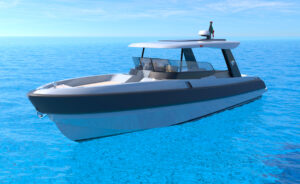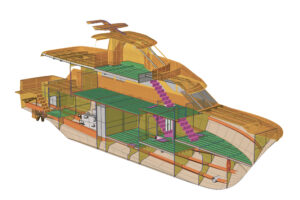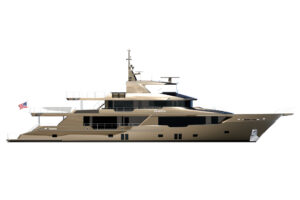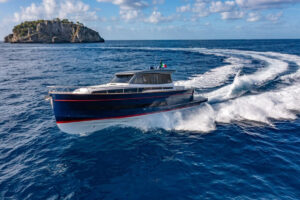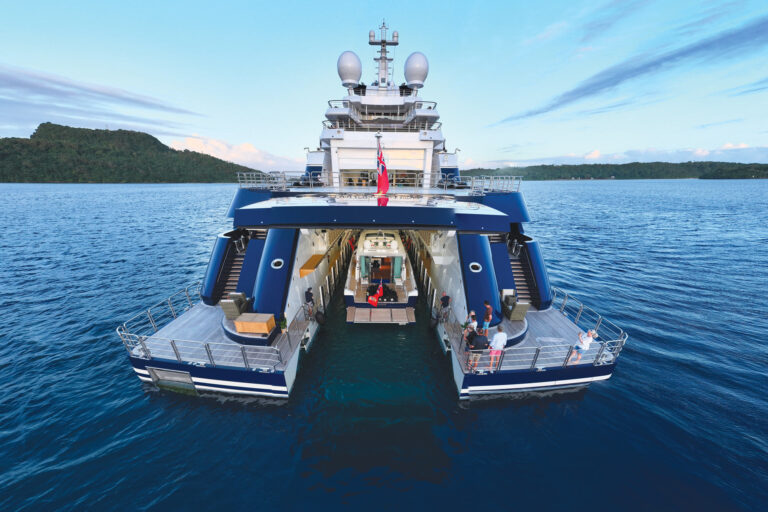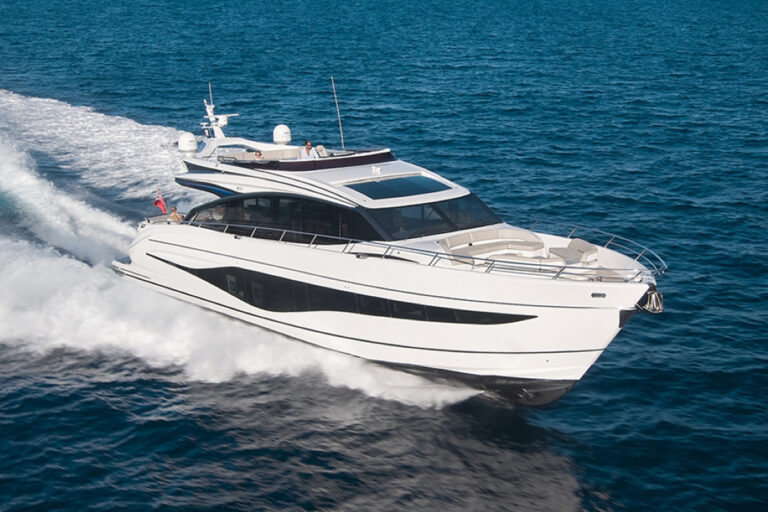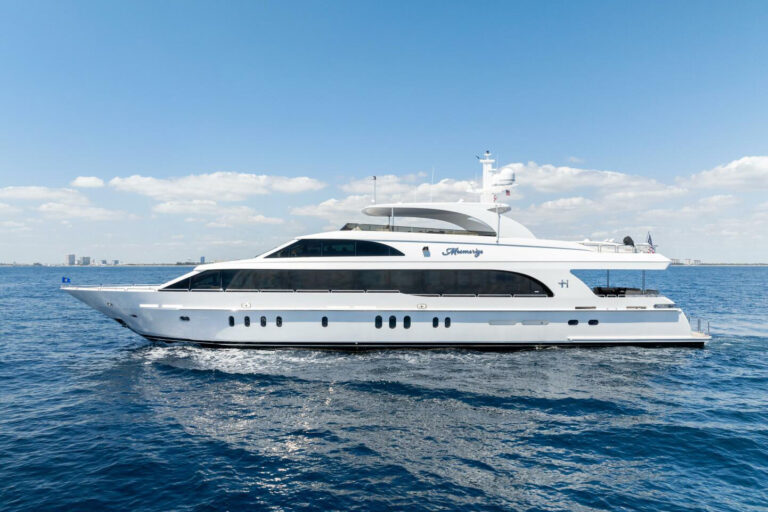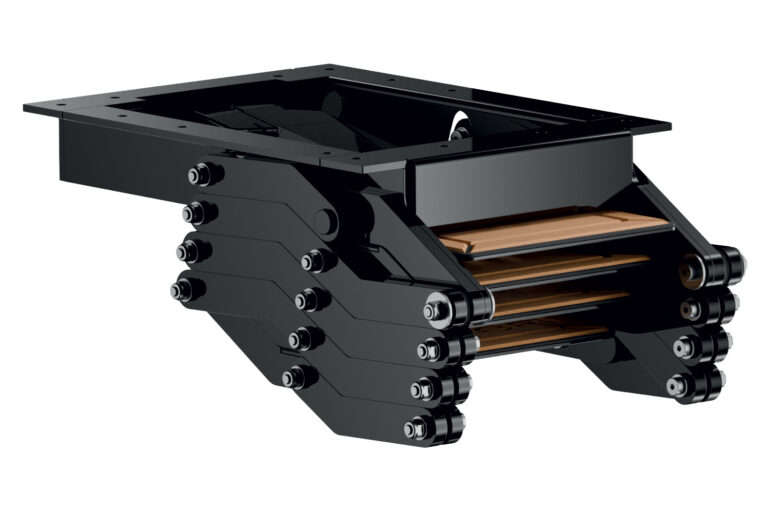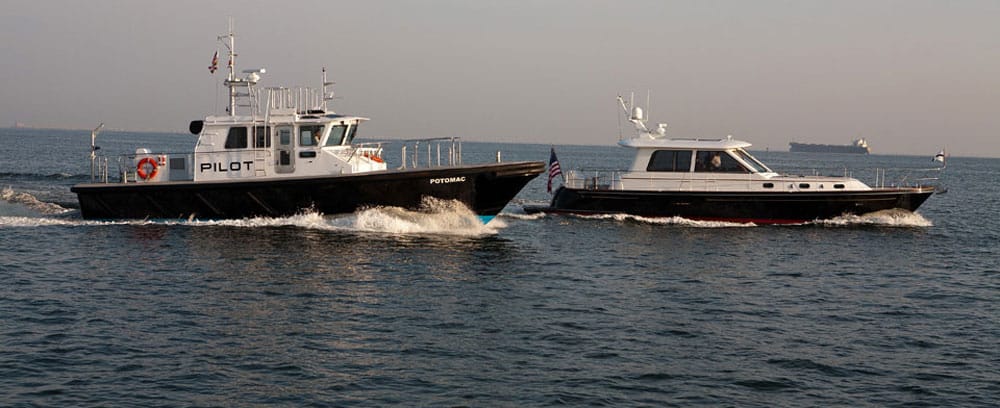
Hunt and Hunt
Capt. Bob Mitchell slowed our pilot boat to match the speed of the freighter, the topsides of which rose above our port bow like a nightmare. She rode high in the water, the Plimsoll line that marks her maximum payload well above the surface. As we closed the distance between us, she revealed the spots of rust, scrapes and dents that she had earned in a hard life at sea and in port.
Mitchell, one of the drivers for the Association of Maryland Pilots, drew us closer and closer to the ship. His experience told him that she was traveling at 10 to 12 knots, and he adjusted our speed to match. When he was satisfied with our pace, I glanced at the GPS — 12 knots it was. Now we were in the ship’s wave-making pattern, and our 53-foot pilot boat closed and retreated, closed and retreated, as Mitchell worked the port bow into the side of the ship. A massive rubber rail at the sheer line protects the pilot boat’s aluminum structure and cushions the inevitable impact when the hulls meet. I reached for a handhold, but when the hulls touched, the bump reminded me of an aircraft’s touchdown, distinct but not especially harsh. Mitchell’s skillful control of the throttles and wheel kept the pilot boat in touch with the ship at an angle of about 30 degrees.
We were only observers in this operation. The Potomac, another of the Maryland pilot boats, followed us in and would receive the departing pilot. The pilot run between Norfolk, Virginia, and Baltimore, Maryland, is the longest in U.S. waters, and ours had been aboard since the ship left Baltimore, roughly eight hours earlier. Our sister pilot boat maneuvered through the turbulence near the ship’s waterline and snuggled up against her hull. A short while later, the pilot appeared on the deck of the ship, near the rope ladder he’d descend, and sent his kit on a line to the deckhand aboard the pilot boat. After the deckhand stabilized the ladder, the pilot descended.
See the complete photo gallery here.

The team couldn’t have asked for more benign weather — hazy, hot, humid, flat seas and less than 5 knots of wind. I tried to imagine our exercise in the dead of winter, wind howling out of the northeast, stacking up vicious seas as it drives the water onto the shoaling bottom, but I failed. Those conditions regularly test the design and construction of the pilot boats, year after year, and so far, the current fleet of deep-V’s from C. Raymond Hunt Associates has passed with top grades.
Hunt has been designing deep-V boats for commercial and military use for about 30 years, and the lessons the team has learned from these extremely demanding applications are often incorporated into Hunt Yachts’ production boats and the design firm’s custom pleasure boats, such as the lovely 55-foot Whistler built by Lyman-Morse in 2008-2009 (read the review here) — and vice versa. To demonstrate the importance of this give-and-take, C. Raymond Hunt Associates and Hunt Yachts arranged to have Blue Moon, a Hunt 52 yacht, join us at the pilot stations in Virginia Beach, Virginia.
The facilities for the Virginia Pilot Association and the Association of Maryland Pilots are cheek-by-jowl in Lynnhaven Bay just around the corner from the Lynnhaven Inlet. Although the Virginia pilots have been using the Hunt 51 Virginia Class boats for more than 20 years, the Maryland pilots didn’t commission their first Hunt-designed 53-footers until 2002. Known as the Chesapeake Class, the type also has found favor in Texas, Massachusetts, Delaware and Florida.
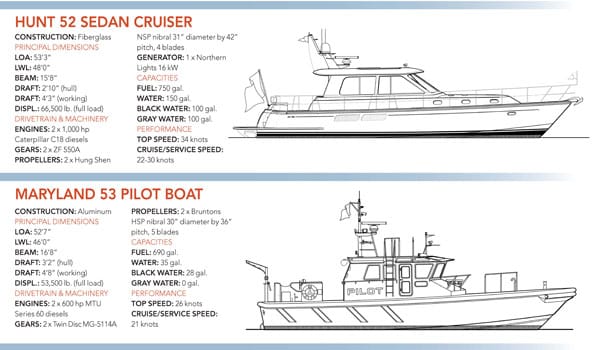
From the sheer line to the keel, the 53-foot Chesapeake Class is remarkably similar to the Hunt 52 yacht, and all of the magic takes place below the waterline. “These boats handle so well,” said Capt. Mitchell. The constant deadrise that C. Raymond Hunt drew into his early deep-V hulls no longer applies. All of the firm’s current hulls have a warped-plane bottom, meaning that the degree of deadrise changes gradually from the 55 to 60 degrees at the entry, to a relatively modest 20 to 21 degrees at the transom.
“If you’ve got a boat with constant deadrise,” said Winn Willard, director of Hunt Yachts and vice president of the design firm, “it’ll adopt one trim angle at almost any speed. A warped bottom causes the boat to rise and fall more gradually.”
A properly designed deep-V shouldn’t carry the transom deadrise too far forward, because this causes the boat to pound. Sharp sections and fine waterlines give the boat a soft ride, but if the designer takes this shape too far, the bow will dig deeply into the seas, ship water over the forward sections or cause the boat to broach. The design team has found the right compromise in the 52-foot sedan yacht and the 53-foot pilot boat.
Before Hunt, pilot boats typically had a deep keel, round bilges, a single engine and a top speed of 15 to 16 knots — semidisplacement hulls. They had a comfortable motion in a seaway but they liked to roll in beam seas. Holding these boats to the hull of a freighter created a high-pressure area between the keel and the hull of the ship, drawing the keel toward the ship and heeling the pilot boat outboard. This dynamic instability limited the semidisplacement boats to a speed of 6 to 8 knots during the pilot’s transfer.
Hunt’s deep-V’s don’t have this problem. At rest or moving at displacement speed, these hulls get their lateral stability from wide chine flats, which narrow progressively from stern to just forward of amidships. As the boat gains speed, the flats enhance lift, as do the lift strips running aft on each side of the V. The strips are large and sharp, and they reduce wetted surface area, which cuts drag. They also direct the water down and out, deflecting spray but, more important, adding lift and dynamic stability. These design elements make the handling characteristics of the Hunt deep-V ideal for duty as a pilot boat, allowing it to stay on plane at 10 to 12 knots while the pilot transfers from one vessel to the other.
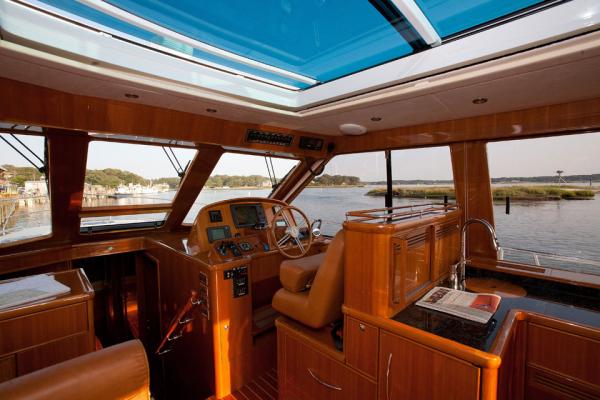
__
The Hunt 52 Blue Moon delights the senses. Her combination of luxury, solid construction, exhilarating performance and exceptional, but conservative, good looks promise to endear her to the owners for a long time. Winn Willard said that C. Raymond Hunt Associates designs its boats from the outside in. The team draws the lines to suit the boat’s usage, payload, speed potential and countless other requirements, and then draws an arrangement plan that fits well into the shell and pleases the client. This approach largely accounts for the aesthetics. A lot of yachtsmen like the look — I certainly do.
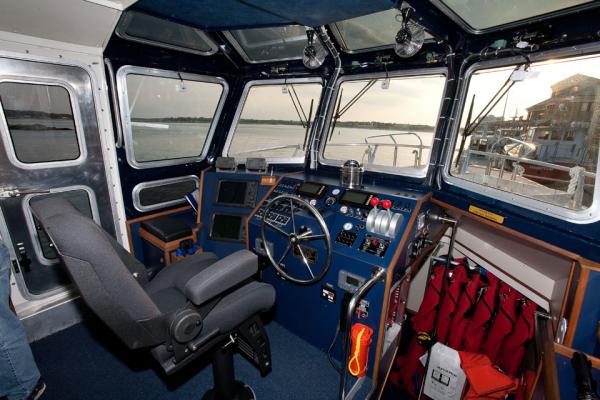
On the other hand, I like the look and feel of the pilot boats — their utilitarian honesty. The requirements of their duty have determined their appearance. The biggest surprise of the day was how quiet these bare-bones aluminum workboats are, even at their maximum speed of 26 knots. I could imagine converting one of them to a minimalist cruising boat. Hunt Associates designed everything for ease of maintenance. The wheelhouse, for example, is farther forward than ideal to get the smoothest ride for the crew, but the location allows the mechanics to pull an engine in about two hours without disturbing the interior of the house. The safety rails flow hot water to keep them from icing during the winter; a compartment on the starboard side of the coachroof holds a grappling device for rescuing crew gone overboard. Decks are flush to let the crew easily move from one part of the boat to another.
Willard reminded me that naval architects never stop learning, which is a great part of the profession’s appeal. If practice makes perfect, Hunt Associates and Hunt Yachts are well on the way to perfection. Meeting the uncompromising demands of commercial, military and leisure vessels keeps the team on its toes, always looking for ways to improve already excellent designs. Yachtsmen reap the benefits.
C. Raymond Hunt Associates, 508-717-0600; www.crhunt.com
Hunt Yachts, 401-324-4201; www.huntyachts.com

